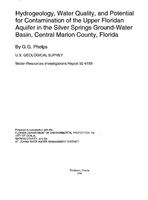The Upper Floridan aquifer, composed of a thick sequence of very porous limestone and dolomite, is the principal source of water supply in the Silver Springs ground-water basin of central Marion County, Florida. The karstic nature of the local geology makes the aquifer susceptible to contaminants from the land surface. Contaminants can enter the aquifer by seepage through surficial deposits and through sinkholes and drainage wells. Potential contaminants include agricultural chemicals, landfill leachates and petroleum products from leaking storage tanks and accidental spills. More than 560 sites of potential contamination sources were identified in the basin in 1990. Detailed investigation of four sites were used to define hydrologic conditions at representative sites. Ground-water flow velocities determined from dye trace studies ranged from about 1 foot per hour under natural flow conditions to about 10 feet per hour under pumping conditions, which is considerably higher than velocities estimated using Darcy's equation for steady-state flow in a porous medium. Water entering the aquifer through drainage wells contained bacteria, elevated concentrations of nutrients, manganese and zinc, and in places, low concentrations of organic compounds. On the basis of results from the sampling of 34 wells in 1989 and 1990, and from the sampling of water entering the Upper Floridan aquifer through drainage wells, there has been no widespread degradation of water quality in the study area. In an area of karst, particularly one in which fracture flow is significant, evaluating the effects from contaminants is difficult and special care is required when interpolating hydrogeologic data from regional studies to a specific. (USGS)


